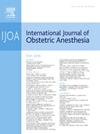实施增强剖宫产后恢复方案前后严重孕产妇发病率的种族健康差异:纽约市两家医院的回顾性观察研究(2016-2020)
IF 2.6
3区 医学
Q2 ANESTHESIOLOGY
引用次数: 0
摘要
背景剖宫产后增强恢复(ERAC)是一种以证据为基础的途径,旨在提高所有患者的护理质量。护理标准化一直被视为促进平等和公平的工具。我们的目的是评估实施ERAC计划前后患者中严重产妇发病率(SMM)的种族差异。方法对2016年10月至2020年9月在纽约市两家大型学术医院实施erac前后的剖宫产患者进行回顾性研究。建立Logistic回归模型,按种族比较erac前、erac后和总体围生期SMM并发症。结果7812例剖宫产患者中,erac术前4640例(59.4%),erac术后3172例(40.6%)。在总体人群中,黑(aOR 1.57, 95% CI 1.07 ~ 2.28;P=0.018)和亚洲(aOR 1.61, 95% CI 1.20 ~ 2.14;P=0.001)患者的SMM发生率高于白人患者。Pre-ERAC,黑色(aOR 1.92, 95% CI 1.16 - 3.14;P=0.010)和亚洲患者(aOR 1.86, 95% CI 1.26 ~ 2.74;P=0.002)患SMM的几率高于白人患者。erac后,这种关系不再具有统计学意义[Black (aOR 1.13, 95% CI 0.61 ~ 2.01;P=0.69)和亚洲(aOR 1.39, 95% CI 0.88 ~ 2.17;P = 0.15)。结论ERAC方案的实施改善了不同种族的SMM结果。ERAC协议的标准化实践可以通过减少产科护理的差异来帮助解决差异。本文章由计算机程序翻译,如有差异,请以英文原文为准。
Racial health disparities in severe maternal morbidity before and after implementation of an enhanced recovery after cesarean delivery protocol: a retrospective observational study at two NYC hospitals (2016–2020)
Background
Enhanced recovery after cesarean delivery (ERAC) is an evidence-based pathway that aims to improve the quality of care for all patients. Standardization of care has been seen as a tool to promote equality and equity. Our goal was to evaluate racial differences in severe maternal morbidity (SMM) among patients before and after implementation of an ERAC program.
Methods
A retrospective study was performed among cesarean delivery patients pre- and post-ERAC implementation at two large academic hospitals in New York City from October 2016 to September 2020. Logistic regression models were created to compare peripartum SMM complications pre-ERAC, post-ERAC, and overall, by race.
Results
The sample consisted of 7,812 cesarean delivery patients, of which 4,640 were pre-ERAC (59.4%) and 3172 were post-ERAC (40.6%). Within the overall population, Black (aOR 1.57, 95% CI 1.07 to 2.28; P=0.018) and Asian (aOR 1.61, 95% CI 1.20 to 2.14; P=0.001) patients had higher odds of SMM compared to white patients. Pre-ERAC, Black (aOR 1.92, 95% CI 1.16 to 3.14; P=0.010) and Asian patients (aOR 1.86, 95% CI 1.26 to 2.74; P=0.002) had higher odds of SMM relative to white patients. Post-ERAC, this relationship was no longer statistically significant [Black (aOR 1.13, 95% CI 0.61 to 2.01; P=0.69) and Asian (aOR 1.39, 95% CI 0.88 to 2.17; P=0.15)].
Conclusion
Implementation of the ERAC protocol improved SMM outcomes by race. Standardization of practices in ERAC protocols can help address disparities by reducing variations in obstetrical care.
求助全文
通过发布文献求助,成功后即可免费获取论文全文。
去求助
来源期刊
CiteScore
4.70
自引率
7.10%
发文量
285
审稿时长
58 days
期刊介绍:
The International Journal of Obstetric Anesthesia is the only journal publishing original articles devoted exclusively to obstetric anesthesia and bringing together all three of its principal components; anesthesia care for operative delivery and the perioperative period, pain relief in labour and care of the critically ill obstetric patient.
• Original research (both clinical and laboratory), short reports and case reports will be considered.
• The journal also publishes invited review articles and debates on topical and controversial subjects in the area of obstetric anesthesia.
• Articles on related topics such as perinatal physiology and pharmacology and all subjects of importance to obstetric anaesthetists/anesthesiologists are also welcome.
The journal is peer-reviewed by international experts. Scholarship is stressed to include the focus on discovery, application of knowledge across fields, and informing the medical community. Through the peer-review process, we hope to attest to the quality of scholarships and guide the Journal to extend and transform knowledge in this important and expanding area.

 求助内容:
求助内容: 应助结果提醒方式:
应助结果提醒方式:


